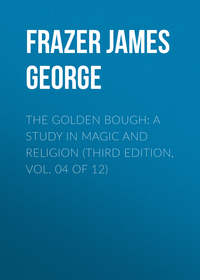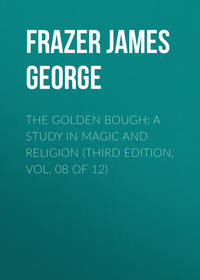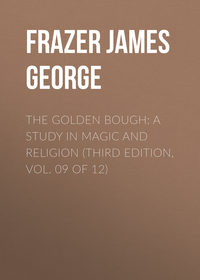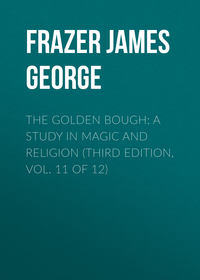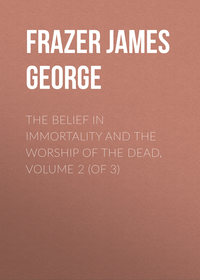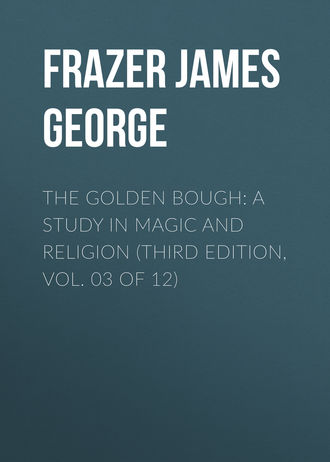 полная версия
полная версияThe Golden Bough: A Study in Magic and Religion (Third Edition, Vol. 03 of 12)
551
Narrative of the Captivity and Adventures of John Tanner (London, 1830), p. 123. As to the custom of not stepping over a person or his weapons, see the note at the end of the volume.
552
J. G. Bourke, On the Border with Crook (New York, 1891), p. 133; id., in Folk-lore, ii. (1891) p. 453; id., in Ninth Annual Report of the Bureau of Ethnology (Washington, 1892), p. 490.
553
J. G. Kohl, Kitschi-Gami, ii. 168.
554
Narrative of the Adventures and Sufferings of John R. Jewitt (Middletown, 1820), pp. 148 sq.
555
J. de Smet, in Annales de la Propagation de la Foi, xiv. (1842) pp. 67 sq. These customs have doubtless long passed away, and the Indians who practised them may well have suffered the extinction which they did their best to incur.
556
J. Adair, History of the American Indians (London, 1775), p. 163.
557
J. Adair, History of the American Indians, pp. 380-382.
558
Maj. M. Marston, in Rev. Jedidiah Morse's Report to the Secretary of War of the United States on Indian Affairs (New-haven, 1822), Appendix, p. 130. The account in the text refers especially to the Sauk, Fox, and Kickapoo Indians, at the junction of the Rock and Mississippi rivers.
559
H. A. Junod, “Les Conceptions physiologiques des Bantou sud-africains et leurs tabous,” Revue d'Ethnographie et de Sociologie, i. (1910) p. 149.
560
For more evidence of the practice of continence by warriors, see R. Taylor, Te Ika A Maui, or New Zealand and its Inhabitants,2 p. 189; E. Dieffenbach, Travels in New Zealand, ii. 85 sq.; Ch. Wilkes, Narrative of the United States Exploring Expedition, iii. 78; J. Chalmers, “Toaripi,” Journal of the Anthropological Institute, xxvii. (1898) p. 332; id., Pioneering in New Guinea, p. 65; Van Schmidt, “Aanteekeningen nopens de zeden, etc., der bevolking van de eilanden Saparoea, Haroekoe, Noessa Laut, etc.,” Tijdschrift voor Neêrlands Indie, 1843, deel ii. p. 507; J. G. F. Riedel, De sluikharige en kroesharige rassen tusschen Selebes en Papua, p. 223; id., “Galela und Tobeloresen,” Zeitschrift für Ethnologie, xvii. (1885) p. 68; W. W. Skeat, Malay Magic, p. 524; E. Reclus, Nouvelle Géographie universelle, viii. 126 (compare J. Biddulph, Tribes of the Hindoo Koosh, p. 18); N. Isaacs, Travels and Adventures in Eastern Africa, i. 120; H. Callaway, Religious System of the Amazulu, iv. 437 sq.; Dudley Kidd, The Essential Kafir, p. 306; A. Bastian, Die deutsche Expedition an der Loango-Küste, i. 203; H. Cole, “Notes on the Wagogo of German East Africa,” Journal of the Anthropological Institute, xxxii. (1902) p. 317; R. H. Nassau, Fetichism in West Africa, p. 177; H. R. Schoolcraft, Indian Tribes, iv. 63; J. Morse, Report to the Secretary of War of the U.S. on Indian Affairs (New-haven, 1822), pp. 130, 131; H. H. Bancroft, Native Races of the Pacific States, i. 189. On the other hand in Uganda, before an army set out, the general and all the chiefs had either to lie with their wives or to jump over them. This was supposed to ensure victory and plenty of booty. See J. Roscoe, in Journal of the Anthropological Institute, xxxii. (1902) p. 59. And in Kiwai Island, off British New Guinea, men had intercourse with their wives before they went to war, and they drew omens from it. See J. Chalmers, “Notes on the Natives of Kiwai,” Journal of the Anthropological Institute, xxxiii. (1903) p. 123.
561
See above, pp. 151 sq.
562
A. W. Nieuwenhuis, Quer durch Borneo, i. 350.
563
T. C. Hodson, “The genna amongst the Tribes of Assam,” Journal of the Anthropological Institute, xxxvi. (1906) p. 100.
564
S. Müller, Reizen en Onderzoekingen in den Indischen Archipel (Amsterdam, 1857), ii. 252.
565
J. S. G. Gramberg, “Eene maand in de binnenlanden van Timor,” Verhandelingen van het Bataviaasch Genootschap van Kunsten en Wetenschappen, xxxvi. (1872) pp. 208, 216 sq. Compare H. Zondervan, “Timor en de Timoreezen,” Tijdschrift van het Nederlandsch Aardrijkskundig Genootschap, Tweede Serie, v. (1888) Afdeeling, meer uitgebreide artikelen, pp. 399, 413. Similarly Gallas returning from war sacrifice to the jinn or guardian spirits of their slain foes before they will re-enter their own houses (Ph. Paulitschke, Ethnographie Nordost-Afrikas, die geistige Cultur der Danâkil, Galla und Somâl, pp. 50, 136). Sometimes perhaps the sacrifice consists of the slayers' own blood. See below, pp. 174, 176, 180. Orestes is said to have appeased the Furies of his murdered mother by biting off one of his fingers (Pausanias, viii. 34. 3).
566
N. Adriani en A. C. Kruijt, “Van Posso naar Parigi, Sigi en Lindoe,” Mededeelingen van wege het Nederlandsche Zendelinggenootschap, xlii. (1898) p. 451.
567
S. W. Tromp, “Uit de Salasila van Koetei,” Bijdragen tot de Taal- Land- en Volkenkunde van Nederlandsch-Indië, xxxvii. (1888) p. 74.
568
Dr. L. Loria, “Notes on the Ancient War Customs of the Natives of Logea and Neighbourhood,” British New Guinea, Annual Report for 1894-1895 (London, 1896), p. 52.
569
Rev. J. Chalmers, “Toaripi,” Journal of the Anthropological Institute, xxvii. (1898) p. 333.
570
R. E. Guise, “On the Tribes inhabiting the Mouth of the Wanigela River, New Guinea,” Journal of the Anthropological Institute, xxviii. (1899) pp. 213 sq.
571
C. G. Seligmann, The Melanesians of British New Guinea (Cambridge, 1910), p. 298.
572
C. G. Seligmann, op. cit. pp. 129 sq.
573
C. G. Seligmann, op. cit. pp. 563 sq.
574
P. Franz Vormann, “Zur Psychologie, Religion, Soziologie und Geschichte der Monumbo-Papua, Deutsch-Neuguinea,” Anthropos, v. (1910) pp. 410 sq.
575
J. L. D. van der Roest, “Uit het leven der Bevolking van Windessi,” Tijdschrift voor Indische Taal- Land- en Volkenkunde, xl. (1898) pp. 157 sq.
576
H. von Rosenberg, Der malayische Archipel, p. 461.
577
K. Vetter, in Nachrichten über Kaiser Wilhelms-Land und den Bismarck-Archipel, 1897, p. 94.
578
J. E. Erskine, The Western Pacific (London, 1853), p. 477.
579
Charlevoix, Histoire de la Nouvelle France, vi. pp. 77, 122 sq.; J. F. Lafitau, Mœ urs des sauvages ameriquains, ii. 279. In many places it is customary to drive away the ghosts even of persons who have died a natural death. An account of these customs is reserved for another work.
580
W. H. Keating, Narrative of an Expedition to the Source of St. Peter's River (London, 1825), i. 109.
581
Father Baudin, “Féticheurs, ou ministres religieux des Nègres de la Guinée,” Missions Catholiques, xvi. (1884) p. 332.
582
Juan de la Concepcion, Historia general de Philipinas, xi. (Manilla, 1791) p. 387.
583
G. Loyer, “Voyage to Issini on the Gold Coast,” in T. Astley's New General Collection of Voyages and Travels, ii. (London, 1745) p. 444. Among the tribes of the Lower Niger it is customary for the executioner to remain in the house for three days after the execution; during this time he sleeps on the bare floor, eats off broken platters, and drinks out of calabashes or mugs, which are also damaged. See Major A. G. Leonard, The Lower Niger and its Tribes (London, 1906), p. 180.
584
E. Casalis, The Basutos, p. 258. So Caffres returning from battle are unclean and must wash before they enter their houses (L. Alberti, De Kaffers, p. 104). It would seem that after the slaughter of a foe the Greeks or Romans had also to bathe in running water before they might touch holy things (Virgil, Aen. ii. 719 sqq.).
585
Father Porte, “Les Réminiscences d'un missionnaire du Basutoland,” Missions Catholiques, xxviii. (1896) p. 371. For a fuller description of a ceremony of this sort see T. Arbousset et F. Daumas, Voyage d'exploration au nord-est de la colonie du Cap de Bonne-Espérance (Paris, 1842), pp. 561-563.
586
“Extrait du journal des missions évangeliques,” Bulletin de la Société de Géographie (Paris), IIme Série, ii. (1834) pp. 199 sq.
587
Rev. W. C. Willoughby, “Notes on the Totemism of the Becwana,” Journal of the Anthropological Institute, xxxv. (1905) pp. 305 sq.
588
Rev. J. Roscoe, “Notes on the Bageshu,” Journal of the Royal Anthropological Institute, xxxix. (1909) p. 190.
589
Dudley Kidd, The Essential Kafir, p. 310.
590
C. Wiese, “Beiträge zur Geschichte der Zulu im Norden des Zambesi,” Zeitschrift für Ethnologie, xxxii. (1900) pp. 197 sq.
591
Dudley Kidd, The Essential Kafir, pp. 309 sq.
592
Rev. J. Macdonald, “Manners, Customs, Superstitions, and Religions of South African Tribes,” Journal of the Anthropological Institute, xx. (1891) p. 138; id., Light in Africa, p. 220.
593
A. C. Hollis, The Nandi (Oxford, 1909), p. 74. As to the painting of the body red on one side and white on the other see also C. W. Hobley, Eastern Uganda, pp. 38, 42; Sir H. Johnston, The Uganda Protectorate, ii. 868. As to the custom of painting the bodies of homicides, see below, p. 178 note 1 and p. 186 note 1.
594
H. R. Tate, “Further Notes on the Kikuyu Tribe of British East Africa,” Journal of the Anthropological Institute, xxxiv. (1904) p. 264.
595
C. W. Hobley, “British East Africa,” Journal of the Anthropological Institute, xxxiii. (1903) p. 353.
596
Miss Alice Werner, Natives of British Central Africa (London, 1906), pp. 67 sq.
597
H. Schinz, Deutsch-Südwest-Afrika, p. 321.
598
P. H. Brincker, “Heidnisch-religiöse Sitten der Bantu, speciell der Ovaherero und Ovambo,” Globus, lxvii. (1895) p. 289; id., “Charakter, Sitten und Gebräuche speciell der Bantu Deutsch-Südwestafrikas,” Mittheilungen des Seminars für orientalische Sprachen zu Berlin, iii. (1900) Dritte Abtheilung, p. 76.
599
Id., “Beobachtungen über die Deisidämonie der Eingeborenen Deutsch-Südwest-Afrikas,” Globus, lviii. (1890) p. 324; id., in Globus, lxvii. (1895) p. 289; id., in Mittheilungen des Seminars für orientalische Sprachen zu Berlin, iii. (1900) Dritte Abtheilung, p. 83.
600
Sir H. Johnston, The Uganda Protectorate (London, 1902), ii. 743 sq.; C. W. Hobley, Eastern Uganda (London, 1902), p. 20.
601
M. Weiss, Die Völkerstämme im Norden Deutsch-Ostafrikas (Berlin, 1910), p. 198.
602
Sir H. Johnston, op. cit. ii. 794; C. W. Hobley, op. cit. p. 31.
603
Numbers xxxi. 19-24.
604
E. Casalis, The Basutos, pp. 258 sq.
605
Spencer and Gillen, Native Tribes of Central Australia, pp. 493-495; id., Northern Tribes of Central Australia, pp. 563-568. The writers suggest that the practice of painting the slayers black is meant to render them invisible to the ghost. A widow, on the contrary, must paint her body white, in order that her husband's spirit may see that she is mourning for him.
606
G. H. von Langsdorff, Reise um die Welt (Frankfort, 1812), i. 114 sq.
607
T. Williams, Fiji and the Fijians,2 i. 55 sq.
608
J. Kubary, Die socialen Einrichtungen der Pelauer (Berlin, 1885), pp. 126 sq., 130.
609
F. A. Thevet, Les Singularités de la France Antarctique, autrement nommée Amérique (Antwerp, 1558), pp. 74-76; id., Cosmographie universelle (Paris, 1575), pp. 944 [978] sq.; Pero de Magalhanes de Gandavo, Histoire de la province de Sancta-Cruz (Paris, 1837), pp. 134-141 (H. Ternaux-Compans, Voyages, relations, et mémoires originaux pour servir à l'histoire de la découverte de l'Amérique; the original of Gandavo's work was published in Portuguese at Lisbon in 1576); J. Lery, Historia navigationis in Brasiliam, quae et America dicitur (1586), pp. 183-194; The Captivity of Hans Stade of Hesse, in a. d. 1547-1555, among the Wild Tribes of Eastern Brazil, translated by A. Tootal (London, 1874), pp. 155-159; J. F. Lafitau, Mœurs des sauvages ameriquains, ii. 292 sqq.; R. Southey, History of Brazil, i.2 227-232.
610
“Relation des Natchez,” Voyages au nord, ix. 24 (Amsterdam, 1737); Lettres édifiantes et curieuses, vii. 26; Charlevoix, Histoire de la Nouvelle France, vi. 186 sq.
611
Bossu, Nouveaux Voyages aux Indes occidentales (Paris, 1768), ii. 94.
612
H. R. Schoolcraft, Indian Tribes, iv. 63.
613
J. Teit, “The Thompson Indians of British Columbia,” Memoir of the American Museum of Natural History, The Jesup North Pacific Expedition, vol. i. part iv. (April 1900) p. 357.
614
J. O. Dorsey, “An Account of the War Customs of the Osages,” American Naturalist, xviii. (1884) p. 126.
615
G. Catlin, North American Indians, i. 246.
616
H. H. Bancroft, Native Races of the Pacific States, i. 553; Capt. Grossman, cited in Ninth Annual Report of the Bureau of Ethnology (Washington, 1892), pp. 475 sq. The custom of plastering the head with mud was observed by Egyptian women in mourning (Herodotus, ii. 85; Diodorus Siculus, i. 91). Among some of the aboriginal tribes of Victoria and New South Wales widows wore a thick skullcap of clay or burned gypsum, forming a cast of the head, for some months after the death; when the period of mourning was over, the cap was removed, baked in the fire, and laid on the husband's grave. One of these widows' caps is exhibited in the British Museum. See T. L. Mitchell, Three Expeditions into the Interior of Eastern Australia (London, 1838), i. 251 sq.; E. J. Eyre, Journals of Expeditions of Discovery into Central Australia, ii. 354; G. F. Angas, Savage Life and Scenes in Australia and New Zealand (London, 1847), i. 86; G. Krefft, “On the Manners and Customs of the Aborigines of the Lower Murray and Darling,” Transactions of the Philosophical Society of New South Wales, 1862-1865 (Sydney, 1866), pp. 373 sq.; J. Dawson, Australian Aborigines, p. 66; R. Brough Smyth, The Aborigines of Victoria, i. p. xxx.; W. Stanbridge, “On the Aborigines of Victoria,” Transactions of the Ethnological Society of London, N.S., i. (1861) p. 298; A. Oldfield, “The Aborigines of Australia,” ibid. iii. (1865) p. 248; F. Bonney, “On some Customs of the Aborigines of the River Darling, New South Wales,” Journal of the Anthropological Institute, xiii. (1884) p. 135; E. M. Curr, The Australian Race, i. 88, ii. 238 sq., iii. 21; A. W. Howitt, Native Tribes of South-East Australia, pp. 248, 452; R. Etheridge, jun., “The ‘Widow's Cap’ of the Australian Aborigines,” Proceedings of the Linnaean Society of New South Wales for the Year 1899, xxiv. (Sydney, 1900) pp. 333-345 (with illustrations). In the Andaman Islands mourners coat their heads with a thick mass of white clay (Jagor, in Verhandlungen der Berliner Gesellschaft für Anthropologie, 1876, p. (57); M. V. Portman, “Disposal of the Dead among the Andamanese,” Indian Antiquary, xxv. (1896) p. 57; compare E. H. Man, Aboriginal Inhabitants of the Andaman Islands, pp. 73, 75). Among the Bahima of the Uganda Protectorate, when herdsmen water their cattle in the evening, they plaster their faces and bodies with white clay, at the same time stiffening their hair with mud into separate lumps. This mud is left on the head for days till it crumbles into dust (Sir H. Johnston, The Uganda Protectorate, ii. 626, compare 620).
617
F. Russell, “The Pima Indians,” Twenty-Sixth Annual Report of the Bureau of American Ethnology (Washington, 1908), pp. 204 sq.
618
J. G. Bourke, On the Border with Crook, p. 203.
619
F. Russell, “The Pima Indians,” Twenty-Sixth Annual Report of the Bureau of American Ethnology (Washington, 1908), p. 204.
620
S. Hearne, Journey from Prince of Wales's Fort in Hudson's Bay to the Northern Ocean (London, 1795), pp. 204-206. The custom of painting the face or the body of the manslayer, which may perhaps be intended to disguise him from the vengeful spirit of the slain, is practised by other peoples, as by the Nandi (see above, p. 175). Among the Ba-Yaka of the Congo Free State a man who has been slain in battle is supposed to send his soul to avenge his death on his slayer; but the slayer can protect himself against the ghost by wearing the red tail-feathers of a parrot in his hair and painting his forehead red (E. Torday and T. A. Joyce, “Notes on the Ethnography of the Ba-Yaka,” Journal of the Anthropological Institute, xxxvi. (1906) pp. 50 sq.). Among the Borâna Gallas, when a war-party has returned to the village, the victors who have slain a foe are washed by the women with a mixture of fat and butter, and their faces are painted with red and white (Ph. Paulitschke, Ethnographie Nord-ost-Afrikas: die materielle Cultur der Danâkil, Galla und Somâl (Berlin, 1893), p. 258). When Masai warriors kill enemies in fight they paint the right half of their own bodies red and the left half white (A. C. Hollis, The Masai, p. 353). Among the Wagogo of German East Africa, a man who has killed an enemy in battle paints a red circle round his right eye and a black circle round his left eye (Rev. H. Cole, “Notes on the Wagogo of German East Africa,” Journal of the Anthropological Institute, xxxii. (1902) p. 314). Among the Angoni of central Africa, after a successful raid, the leader calls together all who have killed an enemy and paints their faces and heads white; also he paints a white band round the body under the arms and across the chest (British Central Africa Gazette, No. 86, vol. v. No. 6 (April 30, 1898), p. 2). A Koossa Caffre who has slain a man is accounted unclean. He must roast some flesh on a fire kindled with wood of a special sort which imparts a bitter flavour to the meat. This flesh he eats, and afterwards blackens his face with the ashes of the fire. After a time he may wash himself, rinse his mouth with fresh milk, and paint himself brown again. From that moment he is clean (H. Lichtenstein, Reisen im südlichen Africa, i. 418). Among the Yabim of German New Guinea, when the relations of a murdered man have accepted a bloodwit instead of avenging his death, they must allow the family of the murderer to mark them with chalk on the brow. If this is not done, the ghost of their murdered kinsman may come and trouble them for not doing their duty by him; for example, he may drive away their swine or loosen their teeth (K. Vetter, in Nachrichten über Kaiser Wilhelms-Land und den Bismarck-Archipel, 1897, p. 99). In this last case the marking the face with chalk seems to be clearly a disguise to outwit the ghost.
621
J. Owen Dorsey, “Omaha Sociology,” Third Annual Report of the Bureau of Ethnology (Washington, 1884), p. 369.
622
Plato, Laws, ix. pp. 865 D-866 A; Demosthenes, Contra Aristocr. pp. 643 sq.; Hesychius, s. v. ἀπενιαυτιαμὸς.
623
Euripides, Iphig. in Taur. 940 sqq.; Pausanias, ii. 31. 8. We may compare the wanderings of the other matricide Alcmaeon, who could find no rest till he came to a new land on which the sun had not yet shone when he murdered his mother (Thucydides, ii. 102; Apollodorus, iii. 7. 5; Pausanias, viii. 24. 8).
624
Polybius, iv. 21.
625
Fr. Boas, “The Social Organization and the Secret Societies of the Kwakiutl Indians,” Report of the U.S. National Museum for 1895, pp. 440, 537 sq.
626
Th. H. Ruys, “Bezoek an den Kannibalenstam van Noord Nieuw-Guinea,” Tijdschrift van het koninklijk Nederlandsch Aardrijkskundig Genootschap, Tweede Serie, xxiii. (1906) p. 328. Among these savages the genitals of a murdered man are eaten by an old woman, and the genitals of a murdered woman are eaten by an old man. What the object of this curious practice may be is not apparent. Perhaps the intention is to unsex and disarm the dangerous ghost. On the dread of ghosts, especially the ghosts of those who have died a violent death, see further Psyche's Task, pp. 52 sqq.
627
Meantime I may refer the reader to The Golden Bough, Second Edition, vol. ii. pp. 389 sqq.
628
Narrative of the Adventures and Sufferings of John R. Jewitt (Middletown, 1820), pp. 133, 136.
629
See above, pp. 160 sq.
630
Baron d'Unienville, Statistique de l'Île Maurice (Paris, 1838), iii. 271. Compare A. van Gennep, Tabou et Totémisme à Madagascar (Paris, 1904), p. 253, who refers to Le Gentil, Voyage dans les Mers de l'Inde (Paris, 1781), ii. 562.
631
U. Lisiansky, Voyage Round the World (London, 1814), pp. 174, 209.
632
A. C. Haddon, “The Ethnography of the Western Tribe of Torres Straits,” Journal of the Anthropological Institute, xix. (1890) p. 397; Reports of the Cambridge Anthropological Expedition to Torres Straits, v. 271.
633
A. C. Haddon, in Journal of the Anthropological Institute, xix. (1890) p. 467.




